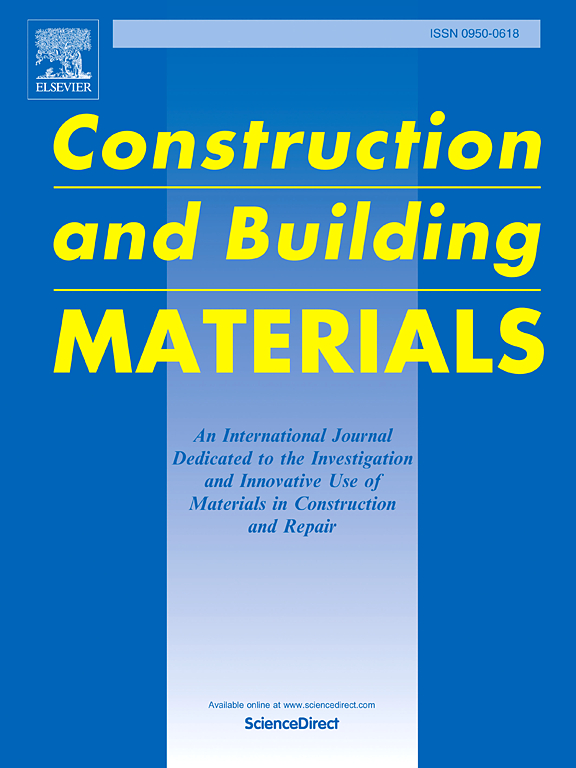煤矸石填料对温拌沥青(WMA)短期和长期断裂性能影响的实验室研究:面向可持续路面的生产
IF 8
1区 工程技术
Q1 CONSTRUCTION & BUILDING TECHNOLOGY
引用次数: 0
摘要
弹性沥青路面(FAP)的横向裂缝(具有拉伸源)和斜向裂缝(具有拉伸+撕裂和撕裂源)在时间依赖性环境条件和长期重复加载下发展和扩展。这些裂缝分为低温自上而下裂缝(LTTDC)和中温自上而下裂缝(ITTDC),随着时间的推移会导致球场表面质量下降。本研究旨在引入可持续的温拌沥青(WMA)混合料,使用一种名为新鲜煤固体废物(FJCSW)的环保添加剂。制备了3种含0 % FJCSW (WF0)、50 % FJCSW (WF50)和100 % FJCSW (WF100)的混合物,并采用三点边缘缺口圆盘弯曲(ENDB)试验进行了试验。该评估侧重于三种类型的裂缝:具有拉伸起源的横向裂缝(模式I),具有拉伸+撕裂起源的斜裂缝(模式I+III)和具有撕裂起源的斜裂缝(模式III)。混合料分别遭受0和1冻融(F-T)损伤。最后,利用弹性模量(Mr)试验对沥青路面减厚进行了经济和环境分析。结果表明:WF50对拉伸型横向裂缝(I型)、拉伸+撕裂型斜裂缝(I+III型)和撕裂型斜裂缝(III型)具有较好的短期和长期性能;此外,由于Mr的增加而导致的厚度下降带来了经济效益,并减少了各个施工阶段的污染物排放,如二氧化碳(CO2)、氮氧化物(NOx)、甲烷气体(CH4)、挥发性有机化合物(VOCs)、二氧化硫(SO2)和颗粒物(PM10)。本文章由计算机程序翻译,如有差异,请以英文原文为准。
Laboratory study of the effect of coal waste filler on short- and long-term fracture properties of warm mix asphalt (WMA): Towards the production of sustainable pavements
Transverse cracks (with tensile origin) and oblique cracks (with tensile + tear and tear origins) on flexible asphalt pavement (FAP) develop and propagate under time-dependent environmental conditions and long-term repeated loading. These cracks, divided into low-temperature top-down cracks (LTTDC) and intermediate-temperature top-down cracks (ITTDC), cause a decrease in the course surface quality over time. The present study aimed to introduce sustainable warm mix asphalt (WMA) mixes using an environmentally friendly additive named Fresh Jig Coal Solid Waste (FJCSW). Three mixtures containing 0 % FJCSW (WF0), 50 % FJCSW (WF50), and 100 % FJCSW (WF100) were prepared and tested using the three-point edge notched disc bend (ENDB) test. This evaluation focused on three types of cracks: transverse cracks with a tensile origin (mode I), oblique cracks with tensile+tear origins (mode I+III), and oblique cracks with a tear origin (mode III). The mixes were subjected to 0 and 1 freeze-thaw (F-T) damage. Finally, an economic and environmental analysis was conducted on the asphalt pavement thickness reduction, utilizing the resilient modulus (Mr) test. The results showed that the WF50 had better short- and long-term behavior against transverse cracks with tensile origin (mode I), oblique cracks with tensile+tear origin (mode I+III), and oblique cracks with tear origin (mode III). Also, the decline in thickness owing to the boost in the Mr led to economic benefits and reduced pollutants emissions such as carbon dioxide (CO2), nitrogen oxides (NOx), methane gas (CH4), volatile organic compounds (VOCs), sulfur dioxide (SO2), and particulate matter (PM10) in the various construction stages.
求助全文
通过发布文献求助,成功后即可免费获取论文全文。
去求助
来源期刊

Construction and Building Materials
工程技术-材料科学:综合
CiteScore
13.80
自引率
21.60%
发文量
3632
审稿时长
82 days
期刊介绍:
Construction and Building Materials offers an international platform for sharing innovative and original research and development in the realm of construction and building materials, along with their practical applications in new projects and repair practices. The journal publishes a diverse array of pioneering research and application papers, detailing laboratory investigations and, to a limited extent, numerical analyses or reports on full-scale projects. Multi-part papers are discouraged.
Additionally, Construction and Building Materials features comprehensive case studies and insightful review articles that contribute to new insights in the field. Our focus is on papers related to construction materials, excluding those on structural engineering, geotechnics, and unbound highway layers. Covered materials and technologies encompass cement, concrete reinforcement, bricks and mortars, additives, corrosion technology, ceramics, timber, steel, polymers, glass fibers, recycled materials, bamboo, rammed earth, non-conventional building materials, bituminous materials, and applications in railway materials.
 求助内容:
求助内容: 应助结果提醒方式:
应助结果提醒方式:


